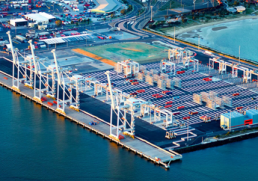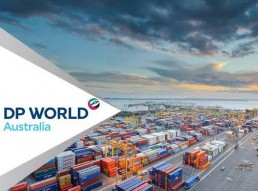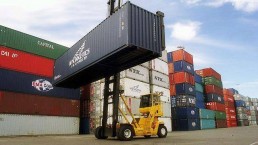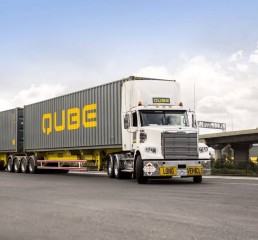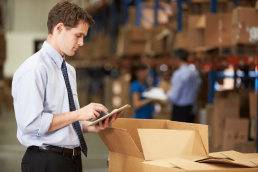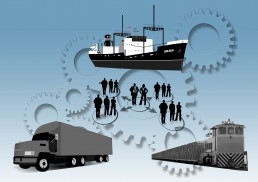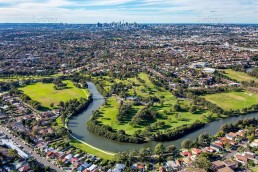MUA stop work meeting in Melbourne and Brisbane
Dear Valued Clients,
Please be advised there will be an MUA stop work meeting in:
Melbourne on Wednesday 6 November from 12.00 – 16.00.
All terminal operations will cease during this time.
Brisbane on Thursday 7 November from 11.00 – 15.00.
Vessel operations and road operations to the Old Terminal are affected. Road operations to the automated modules will continue as normal.
Kind Regards,
SILA Customer Service
DP World Australia - Increase in Infrastructure Surcharges
Dear Valued Clients,
DP World Australia has released details of increases to their Terminal Access Charge (formerly known as an Infrastructure Surcharge) and other ancillary charges at their Port Botany, Fisherman Island, Fremantle and West Swanson Terminal operations.
Please find below list of updated Infrastructure Surcharges/Terminal Access Charge applicable from 1st January 2020:
DPWA Brisbane: AUD 94.00 per container*
DPWA Sydney: AUD 96.00 per container*
DPWA Melbourne: AUD 103.00 per container*
DPWA Fremantle: AUD 50.00 per container*
* All charges exclude GST
Kind Regards,
SILA Customer Service
Newcastle Empty Container Collection/Dehire via Port Botany
Dear Valued Clients,
A reminder that all empty container collection and dehire for Newcastle Import or Export shipments via Port Botany are required to be to/from DP World Logistics Australia Park 1.
Any container that is required to be collected or dehired to/from another container park will incur an additional cost. This additional cost covers the Newcastle MT Transport Fees to/from the alternate depot, depot booking fee & MT staging at DPWL1 to meet our rail service.
MT Collection / Dehire: AUD 235.00 per 20GP*
AUD 385.00 per 40GP*
* Amounts subject to change and administration fees from suppliers
Charges will be effective from 1st November 2019.
Kind Regards,
SILA Customer Service
Qube/MCS Cooks River – Peak Season Notification Container Chain Fee Increase
Dear Valued Clients,
Qube Logistics has provided us with an announcement of a Peak Season Notification Fee increase from 16 September 2019 at Qube/MCS Cooks River Empty Container Depot.
The announcement increases the Cooks River Notification Container Fee to the below:
- Monday 0500hr - Saturday 0500hr : AUD $45.00 per notification
- Saturday 0600hr to Sunday: AUD $55.00 per notification (weekends by prior arrangement)
Qube has explained that this is to allow for extended hours of operation, and the allocation of more equipment to service peak demands, including to try to help to alleviate MT de-hires delayed by BMSB fumigation intervention over the coming months.
We understand that Qube will review this pricing at the end of the peak season and adjust accordingly.
As with all ports in Australia though, the combination of lower volumes of empty containers managed through traditional empty container depots, and the rise in the direct de-hire of empty containers to wharf facilities (estimated to be at least 20% of empty de-hire volumes) is also affecting depot margins and costs.
These are significant increases that cannot be absorbed by container transport operators, and will need to be passed on in the logistics chain.
Kind Regards,
SILA Customer Service
Is a career in Logistics and Supply Chain Management for you?
If you’re a frequent online shopper, there’s a good chance you’ll be all too familiar with that “add to cart” button. But, have you taken the time to think about what happens next? You may not be aware, but there’s a huge network and a flurry of activity that takes place behind the scenes to allow for the creation and distribution of products to your very doorstep. With the continued increase in e-commerce to the developing nations around the world, moving people, goods, and services is more important than ever. This gives rise to more opportunities for careers within the field of logistics and supply chain management (SCM). A progressive career in this industry is a great career pathway, and here at SILA, we love what we do, so it’s something that we encourage others to explore.
Is logistics and supply chain management (SCM) a good career pathway?
The Logistics industry is one of the most important in the world. Without the planning and execution of resource distribution, society would simply fail to function. Logistics isn’t a sexy industry that gets a lot of attention, but it employs nearly half a million Australians and accounts for nearly 10% of our GDP. Despite the associated stereotypes (think overworked truckies and stressed warehouse workers), it’s a great career pathway with many exciting opportunities for young graduates to explore.
What type of jobs are involved in logistics and SCM?
There are many different industries and organisations that are dependent on logistics. Working in this sector can even mean travelling to several domestic or international locations. You must be a reliable person who is prepared to travel for business trips, client visits, and be open to placement in foreign locations. Additionally, your workspace can range from camping out in an office, operating machinery on a factory floor, or approving packages in a delivery centre.
There are currently approximately 10,000 jobs advertised in the transport and logistics sector in Australia. Coupled with a 38.4% job growth in the last 5 years, the future for those in this field is very promising, with more and more opportunities being created. Below you can find a brief overview of the most sought out jobs in logistics and supply chain management
Procurement Manager:
- Responsible for the sourcing of suppliers, contractual negotiation with suppliers, and oversight of all orders and purchases. This person has great interpersonal relationships and good teamwork.
Distribution Centre Manager:
- Responsible for managing the movement, organisation, supply and storage of goods in the centre. This person is a leader and well-organised with excellent communication and customer service skills.
Operations Manager:
- Responsible for coordinating and planning the business operations to ensure that day-to-day tasks run efficiently, whilst additionally overseeing all staff, projects and clients. This person has attained significant leadership experience or training over their career, has great attention to detail and excellent stakeholder engagement.
Logistics Manager:
- Reporting directly to the CEO, they are often responsible for the whole supply chain - managing the purchasing of goods, movement, storage, scheduling and delivery. This person has a strong ability to work well with others and previous experience with managing employees, negotiation and conflict resolution.
How can I start my career in logistics and SCM?
One option of gaining admittance into the logistics industry is by studying for a degree or diploma. This isn’t compulsory, but it could certainly help you. Some companies prefer to hire individuals with a minimum of a bachelor’s degree from an institution. Oftentimes, students choose to specialise in supply chain management or systems engineering.
An alternative to this could be to jump into the industry by starting from the bottom. Some entry-level positions may not require qualifications. These could include customer service roles, delivery drivers, or distribution clerks. The idea here is to work your way up the hierarchy and potentially gain some additional education on the way to bolster your opportunities.
In addition to studying and gaining real experience, it’s important to remember that to be a successful professional in the logistics industry, there are various skills you must work on and keep in mind all times.
- Interpersonal skills
- Extensive industry knowledge
- Team player
- Adaptability
- Strong numerical and analytical skills
- Big picture thinking
- Decision-making
- Accountability
- Attention to detail
We love working in logistics and hope this blog will inspire those who are considering a career in the industry to give it some serious thought.
To learn more about SILA’s services, head to our website www.sila.net.au or get in touch with our friendly teams in Australia or New Zealand:
Australia
Email sales@sila.net.au
Phone +61 7 3908 1690
New Zealand
Email sales@sila.net.nz
Phone +(07) 3733 2685
Melbourne Office - We Are Moving!
WE ARE MOVING!
Please note that SILA Global Melbourne office will move effective 1st October 2019.
New office address will be:
SILA Global Pty Ltd
The Executive Centre
Level 23, Collins Square Tower Five
727 Collins Street
Melbourne VIC 3008
If sending Bills of Lading via post please send to Head Office:
SILA Global Pty Ltd
Unit 13/35 Paringa Road
Murarrie QLD 4172
If you have any questions please contact your local SILA representative.
How the Federal Government is "Delivering on Freight"
As a global logistics company, SILA wants to deliver seamless supply chain solutions for our clients, so we have a vested interest in what the Federal Government is doing to support Australia’s freight system, which it acknowledges to be the lifeblood of our economy. Each year, Australia’s transport and logistics providers deliver about four billion tonnes of goods across the country, which equates to 163 tonnes of freight for every person.
Freight supply chains are responsible for getting petrol to the service station, food to supermarket shelves, household trash to the tip, and essential pharmaceuticals to our hospitals. They connect our agricultural regions and resource basins to cities and ports, and deliver Australian produce and minerals to markets in Asia and beyond.
Therefore it’s imperative that our infrastructure, such as railways, roads, airports, and ports, can facilitate the smooth and efficient movement of freight. However, increasing freight volumes, a growing population, congestion, poorly planned and maintained infrastructure and urban encroachment are all impacting on the ability of our infrastructure to support an effective and competitive freight future.
To help position Australia for this challenge and allow us to remain competitive in the global marketplace, a National Freight and Supply Chain Strategy (NFSCS) and Action Plan have been developed by all tiers of Government, with input from the logistics industry, to deliver an integrated, productive and competitive freight sector.
A recent paper, Delivering on Freight, showcases the Federal Government’s contribution to the Action Plan and approach to achieving a nationally integrated freight system that’s more efficient and internationally competitive.
Positioning Australia to Meet the Challenge
Freight volumes continue to grow, particularly in major cities, with urban freight forecast to grow by about 80% over the next 20 years. Added to this is the pressure of an increasing population, with urban congestion already estimated to cost our economy $25 billion per annum.
Infrastructure development is vital for the economic growth of any nation’s economy, and arguably none more so than transport infrastructure. Therefore an innovative and coordinated approach is imperative, while also ensuring that safety and environmental considerations are taken into account.
The NFSCS and Action Plan present a national picture of freight performance in Australia and outlines the goals and priority actions for the government to support a strong and prosperous freight industry.
It’s no easy task, but Assistant Minister to the Deputy Prime Minister, Andrew Gee, says extensive action is already underway to improve our national freight system.
Want more details on what the Federal Government is doing to support the freight industry? Read on …
The NFSCS and Action Plan commits to action in four critical areas:
1.Smarter and Targeted Infrastructure
Examples of actions underway include:
- $4.5 billion Roads of Strategic Importance initiative to connect regional businesses to local and international markets, and better connect regional communities.
- The National and SA Governments’ $5.4 billion upgrade of the North-South Corridor, connecting the Port of Adelaide, Adelaide Airport, the Islington intermodal terminal and other freight terminals and precincts to enhance freight productivity in Adelaide.
2.Enable Improved Supply Chain Efficiency
Examples of actions underway include:
- Implementing the Queensland Transport and Logistics Workforce Strategy and Action Plan 2018-2023, which sets the direction for workforce reform and addresses industry-wide and sector-specific issues by government and industry.
- Governments collaborating with industry to ensure Australia is prepared for the arrival of automated vehicles and other transport innovations.
- A $70 million investment in the development of an advanced train communication and signalling system which is expected to deliver increased rail capacity, improved reliability, efficiency and flexibility, and increased rail safety.
- Integrating community engagement as key elements in the planning and construction of major transport infrastructure, including the Western Sydney Airport, Westconnex and Inland Rail.
3.Better Planning, Coordination & Regulation
Examples of actions underway include:
- City and Regional Deals bringing together the three levels of government to partner on bespoke planning, investment and governance for Australia’s cities and regions to allow for better planning and coordination around key freight corridors and precincts.
- A Productivity Commission inquiry into national transport reforms to investigate whether they are delivering national productivity and safety benefits, and further reform opportunities to improve productivity and safety. A final report will be provided to the Australian Government by April 2020.
- The Westport Strategy is an integrated plan that will guide the WA Government on the planning, development and growth of Perth’s freight needs for the next 50 years and beyond.
- The NSW Government’s Heavy Vehicle Access Policy Framework which outlines a strategic approach for opening up heavy vehicle access in NSW for both state and council roads.
- In SA, the ‘Improving Road Transport for the Agriculture Industry’ project has delivered over $80m of benefits to primary producers and transport operators across the State.
4.Better Freight Location & Performance Data
Examples of actions underway include:
- $5.2 million in the 2019-20 budget to settle the design of a National Freight Data Hub, including arrangements for data collection, protection, dissemination and hosting.
- Transport for NSW’s Freight Performance Dashboard that shows strategic targets from the NSW Freight and Ports Plan 2018-2023 as well as key road, rail and other performance measures.
Just the Beginning ...
The Strategy and Action Plan, released in August 2019, is the starting point to achieve the desired outcomes, and Australian governments will continue to report annually on their progress. The annual reports will provide an opportunity to review freight performance, emerging issues and challenges for particular supply chains, modes or jurisdictions. There will also be major reviews of the Strategy and Action Plan every five years to ensure continuous improvement in supply chain performance, help identify gaps in government or industry actions, and stay focused on efforts to meet Australia’s freight challenge.
Here at SILA, we hope the vision becomes a reality and Australia’s infrastructure continues to allow us to deliver for our clients for decades to come.
For more information on Federal Government plans, read Delivering on Freight here.
To learn more about SILA’s services, head to our website www.sila.net.au or get in touch with our friendly teams in Australia or New Zealand:
Australia
Email sales@sila.net.au
Phone +61 7 3908 1690
New Zealand
Email sales@sila.net.nz
Phone +64 9 390 7942
MCS COOKS RIVER - EMPTY SLOTS INCREASED BY 100%
Dear Valued Client,
We have received notification announcing the 100% increase in the notification fee for MCS Cooks River Empty container depot (MCS) from 16th September 2019.
QUBE Holdings recently acquired MCS with the approval of the ACCC and with this purchase, we find this exorbitant increase in fees with a minimal notice period.
Transport Operators cannot sustain these continuing increasing notification fees when the inadequate system available now for de-hire of empties creates so many other costs in that;
- We must book and pay for timeslots to use within a limited window of time
- The slots can be cancelled with minimal notice by the empty yard and the carrier is re-directed
- We are charged penalties if we are held up through no fault of our own, and ofter because the driver is in a rant unable to gain entry to the container yard due to congestion.
- Our resources are fully extended in such ways as transporting the containers back to our yard, lifting them off and redelivering them so that timeslots can be managed and penalities avoided.
At the port, we are covered under Port Botany Landside Improvement Strategy (PBLIS) where penalties are incurred if the regulations are not adhered to and any increases to charges must be preapproved.
There are no regulations to the empty yards, however, they charge penalties which cannot be reciprocated. We feel that if this increase is left unrestrained then the other empty yards will follow suit.
Unfortunately, if your empty container must be returned to MCS, we will have no alternative than to pass on this cost to you.
Kind Regards,
SILA Global Pty Ltd
How the new IoT (the Internet of Transportation) will Disrupt the World
Technology continues to change the way we do things, providing us with more practical methods to better solve complex problems and enable innovative new approaches. And there’s no stopping the rapid advancement across every area of our life. Just when you think technology has revolutionised most of our essential processes, it seems technological change is not done yet by any means. One area where technology is currently driving massive change is in the transport and logistics sector.
If we’re going to build smart cars and driverless vehicles, it makes sense that today’s infrastructure will simply cease to be adequate. With smart cars, we need smart roads, smart parking, smart public transport systems and more. Enter … Connected Transportation.
Connected Transportation for a modern world
The aim of connected transportation is to facilitate modern, connected, transportation systems that improve safety, mobility and efficiency both now and in the future. As cities get more congested there’s a need to optimise public transportation routes, create safer roads, reduce infrastructure costs, alleviate traffic congestion, and enable more timely emergency responses.
For businesses such as SILA Global, Connected Transportation means the efficient movement of goods with complete visibility across the supply chain. What we’ve achieved with the introduction of our industry-leading technology SV3, cities are now looking to achieve across their entire transport networks.
Startups in a range of global cities are working towards introducing platforms that will disrupt current methods of public and private transportation. They aim to utilise connected vehicles to gather valuable data on how drivers operate their cars, where they travel to, and then use this data to better plan roads and infrastructure. Notable dead spots, particularly in our cars, buses, trains, and ships sparked the need to better connect our vehicles. And, the internet of things is looking to achieve this and work toward keeping people connected at every moment of the day. Whether you are waiting for the subway, driving through an underground tunnel, or even 35,000 feet in the air, technology will keep us and our mode of transport constantly connected.
What to focus on, and how it will impact stakeholders
Obviously, this sounds great in theory, but for it to occur, governments will require both new technology architecture and physical infrastructure to help connected vehicles and transit systems share real-time data with each other and the surrounding environment. This is where different cities need to understand exactly what they need.
There are three key areas they will need to focus on to ensure a successful transition to the era of connected transportation - safety, mobility, and efficiency.
Cities are already using connected transportation to create a safer environment for citizens in numerous ways. For instance, roadside infrastructure notifies drivers if there are upcoming road hazards to ensure they’re prepared for what’s ahead, if the colour of a traffic signal is about to change, and to reduce speed when they’re entering a school zone or high-accident area. These measures are designed to reduce road fatalities and increase safety when travelling, and will only get more sophisticated in years to come via real-time phone connectivity. New technology that car manufacturers are working on will see drivers receive notifications and be alerted to dangerous situations such as someone about to run a red light, a car approaching that’s out of sight beyond a curve, or someone swerving into their lane to avoid an object on the road.
People love convenience and want a seamless mobility experience when it comes to planning and paying for their trips across different modes of transportation, and ideally, we want to do it all in one place. Whether we’re driving to the local store, or about to board an international flight, a simple all-in-one system that can personalise our journey with data-driven accuracy, and the ability to identify setbacks in advance, will be a winner. To make this possible, cities will need to merge the infrastructure assets from multiple modes of transport and integrate it on one platform.
Flow and efficiency are important to the individual, but also businesses. If we can use IoT to connect existing infrastructure to a much larger network with greater data-sharing capabilities, mass transit and logistics systems can monitor their fleets in real-time and make immediate adjustments as needed. This is why we created our SV3 system - to maintain visibility across all locations and modes of transport. It provides our customers with a web-based system that allows them to be part of the journey. Being ‘connected’ not only streamlines processes and enables visibility across the entire supply chain, but it also allows us to deal with disruptions as they occur.
The purpose of transforming private and public transportation is to ultimately improve safety, mobility, and operational efficiency. It is evident that the IoT has already commenced working on this and hopes to eventually alter the way we travel. Whether it’s across the country by plane or from home to work on a bus, the everyday consumer, along with various governments and global businesses will be impacted by this new phenomenon of connected transportation. Next stop, hover cars!
To learn more about SV3 head to our website www.sila.net.au or get in touch with our friendly teams in Australia or New Zealand:
Australia
Email sales@sila.net.au
Phone +61 7 3908 1690
New Zealand
Email sales@sila.net.nz
Phone +64 9 390 7942
Industry News 09/08/19
Welcome to the latest SILA Global Industry News
Real time container tracking to become standard?
"The dam has burst" on the digitalisation of container shipping. Maritime consulting firm Sea Intelligence predicts real-time container tracking will be standard in 600,000 containers worldwide by 2025, as customers expect real-time information and transparency for their shipments.
See what Supply Chain Dive has to say about ocean freight technology here.
Cargo Theft and how to avoid it
Cargo theft is real, and while it will never be completely eradicated, technology can help! The more sophisticated and tech savvy hijackers become, we need to reduce risk and weak spots in the process. Just another reason to have end-to-end visibility of your supply chain.
Read what Freight Waves had to say about the issue here
We can help!
SILA Global is proud to be part of the technology revolution. We can transform your business with innovative supply chain systems that provide transparency, streamline operations & reduce costs.
We have offices in Australia & New Zealand - contact our team to revolutionise the way you manage your supply chain.
